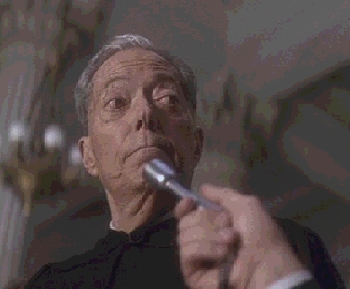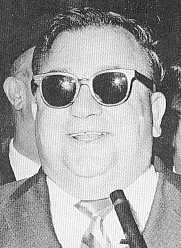Был ли Клей Бертран?
Был ли Клей Бертран?

Jim Garrison (seen here playing Earl Warren in Oliver Stone's JFK)
claimed that Lee Harvey Oswald consorted with a mysterious "Clay Bertrand."
Did "Bertrand" exist?
Ключевой обвиняемый у Гаррисона - Клей Шо, он же как считает Гаррисон "Клэй Бертран". К моменту идентификации мы еще вернемся, а пока попробуем разобраться был ли вообще Клей Бертран.
В понедельник, 25 ноября 1963 , Дин Эндрюс позвонил местным отделениям ФБР и Секретной службы и сообщил им, что Lee Harvey Oswald был его клиентом предыдущим летом и его сопровождал человек по имени Clay Bertrand. Эндрюс сказал, что Бертран позвонил ему 22 ноября с предложением защищать Освальда в Далласе. Он описал Бертрана, как молодого человека 22 - 23 лет, 5 '7", 160 фунтов, светлые волосы и стрижка - ежик. "
Однако, отчеты и данные в конторе Эндрюса не подтверждали того, что Освальд когда либо пользовался услугами Эндрюса. О Бертране, так же не было никаких упоминаний. ФБР и Секретная служба тоже не могли определить местонахождени и никаких следов Клея Бертрана в Новом Орлеане. Такой человек был неизвестен Новоорлеанскому Бюро Идентификации Полицейского Управления, их Детективного подразделения, Отделу по борьбе с наркотиками, и полиции нравов. Не было следов такого человека и в Новоорлеанском Кредитном Бюро. Бюро Занятости штата Луизианы, бюро по трудоустройству Oretna, университет Tulane, или Публичная библиотека, тоже не знали такого человека.
После того, как не было обнаружено никаких следов Бертрана, Эндрюс был допрошен повторно. Он показал, что до этого момента встречался с Бертраном один раз. Но давая описание, он вдруг характеризовал его, как "хорошо одетого человека 6 '1" или 6' 2", с каштановыми волосами".
Полицию заинтересовало такое расхождение в описании и они провели расследование первого и единственного эпизода встречи Эндрюса с Бертраном. Выяснилось, что Эндрюс в это время находился ... в больнице под действием сильнодействующих успокоительных. Позже Дин Эндрюс сам признался, что не смог найти у себя в архивах никаких подтверждений существования Клея Бертрана и согласился, что его память скорее всего выдала за реальность наркотический бред на больничной койке. Он провел на ней все выходные в которые убили Президента.

Dean Andrews
Через два дня, еще не до конца поправившись от лихорадки, Эндрюс разговаривал со своим другом Иеном Дэвисом по телефону и вскользь заговорил о Кеннеди и Освальде. По свидетельству Йена Дэвиса, в разговоре Эндрюс сказал, что если бы он мог заполучит дело Освальда, то это могло сделать его карьеру и он подумывает, что бы попробовать стать его защитником.
Так что вероятнее всего, Эндрюс просто придумал историю, что бы попробовать получить дело Освальда, но после его смерти и дополнительного расследования коммиссии Уоррена, предпочел отказаться от большинства своих заявлений.
Видимо никакого Клея Бертрана не существовало вовсе, и вся возня Гаррисона всего лишь плод воображения Дина Эндрюса и (или) его желания завоевать популярность. Кстати репутация у него была не самая лучшая и даже правдивые заявления Эндрюса обычно вызывали подозрение.
Дальше, я привожу показания Д. Эндрюса - "Комиссии Уоррена":
Andrews explained:
Mr. ANDREWS. I was in Hotel Dieu [Hospital], and the phone rang and a voice I recognized as Clay Bertrand asked me if I would go to Dallas . . . and defend [Oswald]. I told him I was sick in the hospital. If I couldn't go, I would find somebody that could go. . . . I had seen Clay Bertrand once some time ago, probably a couple of years. He's the one who calls in behalf of gay kids normally, either to obtain bond or parole for them. I would assume that he was the one that originally sent Oswald and the gay kids, these Mexicanos, to the office because I had never seen those people before at all. They were just walk-ins. . . .Mr. LIEBELER. Now do you recall talking to an FBI agent, Regis L. Kennedy, and Carl L. Schlaeger on November 25? . . . Do you remember telling [Special Agent Kennedy] at that time that you thought that Clay Bertrand had come into the office with Oswald when Oswald had been in the office earlier last spring?
Mr. ANDREWS. No; I don't remember.
Mr. LIEBELER. Was Bertrand ever in the office with Oswald?
Mr. ANDREWS. Not that I remember.
Didn't you tell the FBI, Liebeler asked, that "you finally came to the conclusion that Clay Bertrand was a figment of your imagination?"
Mr. ANDREWS. That's what the Feebees [FBI agents] put on. I know that the two Feebees are going to put these people on the street looking, and I can't find the guy, and I am not going to tie up all the agents on something that isn't that solid. I told them, "Write what you want, that I am nuts. I don't care." They were running on the time factor, and the hills were shook up plenty to get it, get it, get it. I couldn't give it to them. I have been playing cops and robbers with them. You can tell when the steam is on. They are on you like the plague. They never leave. They are like cancer. Eternal. . . . (20
Now Andrews added a second encounter with Bertrand to his story.
Mr. ANDREWS. Oh, I ran up on that rat about six weeks ago and he spooked, ran in the street. I would have beat him with a chain if I had caught him. . . . I am trying to think of the name of this bar. That's where this rascal bums out. I was trying to get past him so I could get a nickel in the phone and call the Feebees or [Secret Service agent] John Rice, but he saw me and spooked and ran. I haven't seen him since. . . . (21)
Mr. LIEBELER. . . . Now I have a rather lengthy report of an interview that Mr. Kennedy had with you on December 5, 1963, in which he reports you as stating that you had a mental picture of Clay Bertrand as being approximately six-feet-one-inch to six-feet-two-inches in height, brown hair, and well dressed.
Mr. ANDREWS. Yes.
Mr. LIEBELER. Now this description is different, at least in terms of height of the man, than the one you have just given us of Clay Bertrand.
Mr. ANDREWS. But, you know, I don't play Boy Scouts and measure them. I have only seen this fellow twice in my life. I don't think there is that much [difference] in the description. . . .
Mr. LIEBELER. I think you said he was five-feet-eight-inches before.
Mr. ANDREWS. Well, I can't give you any better because this time I was looking for the fellow, he was sitting down. I am just estimating. . . .
Mr. LIEBELER. . . . I am at a loss to understand why you told Agent Kennedy on December 5 that he was six-feet-one to six-feet-two and now you have told us that he was five-feet-eight when at no time did you see the man standing up.
Mr. ANDREWS. Because, I guess[ed] the first time -- and I am guessing now --
Mr. LIEBELER. Is this fellow a homosexual, do you say?
Mr. ANDREWS. Bisexual. What they call a swinging cat.
Mr. LIEBELER. And you haven't seen him at any time since that day?
Mr. ANDREWS. I haven't seen him since.
Mr. LIEBELER. . . . Has this fellow Bertrand sent you business in the past?
Mr. ANDREWS. Prior to -- I guess the last time would be February of 1963.
Mr. LIEBELER. And mostly he refers, I think you said, these gay kids, is that right?
Mr. ANDREWS. Right. . . . I wish I could be more specific, that's all. This is my impression, for whatever it is worth, of Clay Bertrand: His connections with Oswald I don't know at all. I think he is a lawyer without a briefcase. That's my opinion. .
Создано на конструкторе сайтов Okis при поддержке Flexsmm - накрутка инста